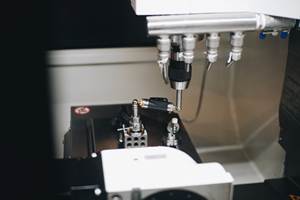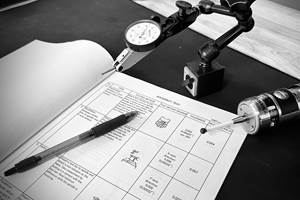Direct Edge Finding Via Laser
A laser edge finder offers a direct method for locating workpiece edges that can save setup time.
Share





Conventional electronic or mechanical edge finders are commonly used during machine setup to position the spindleŌĆÖs center line at the edge of a workpiece. This is considered an indirect positioning method. ThatŌĆÖs because in order to locate the spindleŌĆÖs center line at the edge, an operator must move the table an amount equal to the finderŌĆÖs radius once the finder contacts the workpiece.
SDA Manufacturing, located in Piedra, California, says its Laser Center/Edge Finder offers a direct method for locating workpiece edges that saves setup time. When installed in a drillŌĆÖs chuck or millŌĆÖs spindle via a collet-style tool holder, the laser directs its beam toward the worktable. The laserŌĆÖs dot shows the actual position of the spindleŌĆÖs center line relative to the workpiece, vise or fixture. This visual referencing allows operators to easily position the spindle at specific location points, workpiece centers, centers of holes or scribed lines. It also enables them to quickly align vises; set angular mill head angle; and center indexers and rotary tables.
The laser, housed in 6061 aluminum, has accuracy repeatability of approximately 0.001 inch (0.02 mm). It can be positioned 1 to 12 inches away from its target using a standard polarizing attachment that focuses/minimizes the laserŌĆÖs dot size. The Class IIIa laser device is powered by three 1.5-volt alkaline camera batteries that are said to last from six months to a year, depending on amount of use. The laser functions using a simple on/off switch. After use, it can be turned off and then stored in the machineŌĆÖs ATC just like any other tool.
The standard Laser Center/Edge Finder is 3.375 inches long with a 0.75-inch diameter. It is available in shank sizes of 0.375 inch, 0.5 inch or 10 mm. A mini model measures 2.75 inches long, has a 0.75-inch diameter and shank sizes of 0.25 or 6 mm. The company offers a wet-cabinet version that is designed for use in machines that use coolant. It has the same dimensions as the standard unit, but is available only with a 0.5-inch shank. Once the laser is turned off after use, a vinyl boot can be slid over the device to seal and protect it from moisture.
HereŌĆÖs how shops might put the Laser Center/Edge Finder to use: To measure material size or the width of a hole on a mill, locate the edge of the workpiece or hole with the laser and then null the machineŌĆÖs digital readout (DRO). Move the table so that the laser reaches the opposite edge; the feature size will be indicated on the DRO. To locate the center of a hole, divide the holeŌĆÖs measured diameter in half. Next, move the table that distance in the X axis toward the center of the hole and null the DRO. Finally, the move the table in the Y axis until the laser reaches the edge of the hole and then reverse the amount of the hole radius in the Y axis. That positions the spindle at the center of the hole.
To align a vise, load the vise in the approximate position and snug one of its hold-down bolts. Next, maneuver the table in X and Y axes until the vise jaws and laser dot are aligned and then secure all the hold-down bolts.
To center a workpiece in a latheŌĆÖs four-jaw chuck, place the laser in the tailstock chuck and loosen and tighten the jaws until the laser dot appears on the center punch mark or intersecting scribe lines. To return a tailstock to its center position after off-center taper-turning operations, install the laser in the headstock chuck and place a live or dead center in the tailstock. Move the tailstock so the center is close to the laser and adjust the tailstock side screws until the laser dot aligns with the centerŌĆÖs tip.
Related Content
Marathon Precision’s Engineering Playground: One Shop’s Secret to Sustaining High Tech, Low-Volume and High Morale
Half an airplane on the wall, a ten-foot metal dragon, and a full-blown recording studio might not scream “manufacturing efficiency,” yet Marathon Precision proves otherwise. Here’s how forging, complex CNC operations and staff-driven creative projects combine to fuel the shop’s productivity and profitability.
Read MoreBallbar Testing Benefits Low-Volume Manufacturing
Thanks to ballbar testing with a Renishaw QC20-W, the Autodesk Technology Centers now have more confidence in their machine tools.
Read More6 Machine Shop Essentials to Stay Competitive
If you want to streamline production and be competitive in the industry, you will need far more than a standard three-axis CNC mill or two-axis CNC lathe and a few measuring tools.
Read More4 Ways to Establish Machine Accuracy
Understanding all the things that contribute to a machine’s full potential accuracy will inform what to prioritize when fine-tuning the machine.
Read MoreRead Next
Machine Shop MBA
Making Chips and Modern Machine Shop are teaming up for a new podcast series called Machine Shop MBA—designed to help manufacturers measure their success against the industry’s best. Through the lens of the Top Shops benchmarking program, the series explores the KPIs that set high-performing shops apart, from machine utilization and first-pass yield to employee engagement and revenue per employee.
Read MoreAMRs Are Moving Into Manufacturing: 4 Considerations for Implementation
AMRs can provide a flexible, easy-to-use automation platform so long as manufacturers choose a suitable task and prepare their facilities.
Read More






















